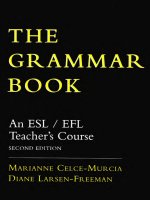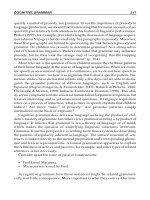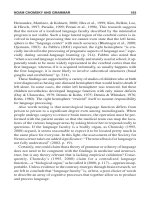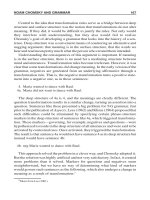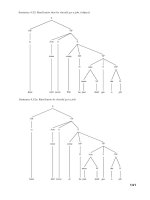The teacher''s magazine - the seasons and the weather
Bạn đang xem bản rút gọn của tài liệu. Xem và tải ngay bản đầy đủ của tài liệu tại đây (5.3 MB, 32 trang )
T%
4
At q6
21
Vernal
Muirm
winter
soistice
Approaching
exam situations
Online images for
your teaching material
Why is argumentation
important?
CILILF
How topüt it
-
intO praéic
Sea ffoldi
!'BEST
PRICE
L
ARAE
I
FOLLOW TJSON
Books and Moj!J
Biggest
dgspecial
III 111111
ii'
I
iii
tacher
If you want to di tribute our products
"Learnin
g
En
g
lish, Lovin
g
Books and More"
contact us at inloii.booksandmore.es
vww.booscaaiLdmoxe.es
-
:
Reading
I4o /
Book
Bulletin Boards
Books
FIrst
T
rlopdia 4ITJ7
Sdence
\
•
.
.
Lucrecia built a veggie garden with her students
and encouraged their families to join in. They picked
lots of vegetables for their school dinner.
At Vittra school to Sweden. there are no walls
delimiting the classroom; each student is free
to experiment in their own way.
Find inspiring educational activities like these ones and share yours in j CJtLbEDIBA
Joiftihe community of those who are suissi.utuiliit about education at club.ediba.com
am
J
Poland
zamowienia@edir www.ediba.com
-
Tel.:
+22 566 77 87_____
-
-
'U
D
ear
colleague,
In this issue we will deal with
the seasons and the weather.
You will find many suggestions and
ideas to work with CLIL, integrating the
topics presented with several areas of
knowledge, which will give you the
possibility of expanding the activities
for your students to make their learning
meaningful. Look for a CLIL plan to
ease your job of planning your lessons.
You will also find some articles for food
for thought with plenty of practical
ideas to be applied to the activities
presented in this issue or any other
topic you have in mind.
We really hope you find this edition
useful and look forward to meeting you
next month.
The Teachers
Magazine
team
Staff; Editu; Patrida Sainz
I
Layout and design: Mado Madies
I
Staffwriters: Ana M. Martinor Mania Starc. Auw Obosa Silvia Gia", Maria -loOVenr6n
/
General =rdlriatiom Adrian 8ala
l
ovsky
/
Adminlittration: Claudia
Traversa. Ser
g
io Vicente(Genenal on rtlinaoon ass &tant:DarioS
eija~~
Di
g
ital archive!Ced Ile Bentive
g
na, Sandra Casa nova/ lustration AlbertoAmadeo. RG
q
ue An
g
el iccho, Femanc1D(errudD,EmrnamwI ChierchieGabrid
Cortina.
MdFia
no Martinr Victor W chez
I
Digital co
lor:.
Gonzalo An
g
uei ra, M6nica Gil, Natalia Sofic
I I
nternatio nal tracle: Wa Iter B@nitez, Pa
blo
Fu sconi
I
Communication and customer se rvice: Carius Sala
j
uvskyr M aia Bala
j
oysk~
I
MIMIngs and train Ing: Micaela Benitez
Cie
udia Ka ne, ConsueJo Nrez Fern~indez
j
En
g
I
ish text editin
g
: Ana M. M ar%ino M
-
a:
n
Q50tiff"S! Maria rka
Med i na
1
Multi media resources: Francisco Del Val ler Leticia
ISSN: I OWS13)
"n
1,
Mau r Iclo P&e4
Pablo
Yun
g
blut
/
Photo
g
raphy: Fernando Acu Fo, M6nica Fal do ni, Andrea Gonzalez, Aidana Meineri,
LisLffa MMZQR 5USana
Natol
I
MarlIcetin
g
and adverti sin
g
:
Fav
io Bala
j
ovsk~. Fe rn.~ndo Bala
j
ovsky,
NO
-
VE
-
MO
-
EN
201
2
Gast6n Monteoliva. Rei rkaWo Perdomo. Maite Val ie rRe Matl
I a '
Recepdonists: Mau ro Do Los Santo; Patricz Perona
/
Computer syste rni and web: Javier Can ussi ni. Leonard o
U
nis. Leandro Regoff, Aa4l Robblani
I
Technical
PdOW
1, SPAIN
Le
g
a
I
Deposit:
".271-2003 1
In
SPAIN
Pu blish ed b
r
. Ediba Europa Eon,
51-
Atenas 2, ofid na Lr 28224 Po~mek~ de Alarro n (M adrid
~ J
Advertise wiffi
u
s!
GraciLla Rodfique7_ Tel
- 9 1352 77 10.
THIS
MAGA-Z I NE 15
publiedibadove
)
eroom i Subscription oontact; Td.91
352 09 113,
e-mall: suscripciones@ovepercom
/
Prepress:
J.
A.
MIMS
I
Printed
by G.
Almudena,' Circulation: Lo
g
iwsta Poblicadorkes
S-L.
Tel.'
91665 7158 /
PORTUGAL:
A PUBLICATION
OF;
Su lbsc r iptiDn cont-xi! maTin a
j
ordao@ed ba.com
/
C"ation, Lo
g
isia Portu
g
al,
5
A-
J
ITAL'Y'. Subscription contact!
be
nedetto bonvenbre@ed iba com i a rcullativin: Press-d i DiStFibuzio ne Stampa Multimedia,
S_
r-
I
.
1
20090
Soy
rate (MI), e-mail:
Re
g
i strazione at Tribunale di Milano con il rn~ mffo
592,
del
06
de Sertembre 2004.
1
n
POLAN D
an
d
CZ
ECH
RE
PU
BLIC pu bihshed
by: ED16A
Polska sp. z o. o.
I
ul. FaMiDwskiego
53~ 02-697
Warszawa
/ POLAW
Subs cription con tact, zamowieniatgedibamm /wwwedi baxom
'
TOL&K 22
566 77 87 1
Circulation in Poland: Pol Perfect s
p-
z
o. c. CZECH REPUBLIC: siuh%rilptlan onniare www-mendcz
GRUPO
EDIBA
O
C 2003
The T"chet's Magarinq
ReproducWn
jr)
who4e orpaM
of
M15 mogazire, IS 3rdwy
fiorbrd*~I,
Mth the uLoprion afp
q
rs labehhsd as 'PhowopjaWe twrivu!W Mqce for VAT-fi,&- pkices, same as cow
pa
g
e
price.
some
you ever seen little kids learning how to
represent the content and the pool, the En
g
lish language.
swim? Well, teachers make them play with
Content and Integrated Language Learning implies using
some floating devices in the shallow water and
English as a means to acquire some other kind of knowledge.
•
without realising how, they are in the middle of
The curious thing is that it is very effective because students
the pool happily floating. The same happens with
pick up
structures naturally as they are thinking about
CLIL and students in this metaphor the floating device would
something else: the content. It is like those optical illusions in
N
which you look at a picture and at the same time you are
looking at a completely
different image.
Traditional Approach
The objective:
En
g
lish
4C
The means:
En
g
lish
CLIL
The objective:
English
means:
other curriculum content
hat content can you use?
Citizenship, Stories, Design, Technology,
)nomics, Geography, History, Math,
asic, Physical Education, Philosophy,
sligious Studies, Politics, Science,
iterature, Information and
ommunication Technology (ICT), etc.
ow is communication
achieved?
udents have to produce the subject
Ater in visual, oral and written forms.
bjert matter is the content related to the
ject chosen. Cognitive and thinking
Is are involved, such as reasoning,
sating, assessing and using critical
:ing; therefore students are challenged to
mething different. Learners also have the
cc of understanding other cultures, being
minded, enriching their own
wtedge
and having a positive attitude
cards learning.
hat language do students use?
udento need to know the basics of
onguage structures and functions. With
CLIL they will be able to understand
concepts and communicate ideas using
different structures and a wide range of vocabulary. Students'
Example of a
CLIL
plan
see
page 7
for
a
blank
model plan)
production resembles native speakers' performance.
How do I write a CLIL lesson plan?
Examples of functions students may put into practice:
Giving examples, describing a process, expressing conditions,
talking about , defining, presenting an argument, giving
reasons, reporting events.
Examples of cognitive skills students may put into practice:
Remembering, thinking, identifying, showing a relationship,
ordering, sequencing, ranking, defining, comparing,
contrasting, dividing, classifying, separating, predicting,
hypothesising, reasoning, evaluating, assessing.
Examples of classroom activities students put into practice:
Relating, spelling, telling, identifying, labelling, locating,
matching, naming, ordering, organising, placing, explaining,
contrasting, distinguishing, investigating, researching, sharing,
grouping, categorising, highlighting, classifying, predicting,
guessing, suggesting, choosing, explaining, justifying, solving,
recommending, building, changing, creating, describing,
inventing, planning, producing, commenting, rating.
Examples of learning skills students may put into practice:
Carrying out investigations, cooperating with others, handling
data, drafting sketches, editing articles, estimating, measuring,
guessing from context, note taking, locating information,
organising information, interpreting information, using senses,
planning, processing information, recording results, reviewing
work, scanning, skimming, solving problems, summarising,
transforming, information.
Examples of subjects and tasks:
History, Geography, Politics, and Philosophy: read, recount,
summarise, report, explain.
Science: hypothesise, observe, describe, record, web search.
Math, Economy: explain, solve, describe, show, predict.
Art, Music, Literature: read,
write,
describe, explain, change.
tCTt enter, explain, represent, show, design.
Examples of different tasks:
Bar chart, mind map, flow chart, grid, line graph, pie chart,
cause-effect diagram, quadrants, storyboard, T-chart, table,
time-line, tree diagram, Venn diagram.
CtC
Alm-
Kjww-
Be
able
so:
Make it suinnwFv of main ideas.
,,,ri5rd
Mk, a dm w in P
5a,i,5
a,
g
revn house
at NWM oft
The students should
be abk N
,
5,er,b, tau e,and
,e',r,rrgvs,I
commookaties
Vaesholary
R udi ation. bral, atmosphere. 51jrfatc, yLtnh ouse,
C'O
:
. 0
!
bum. fozi
I
furl
de
Airestal ion.
~ I
ITL
p I ~
pr cwml,
e.
g
.
-Soiar heaL passes th rou
g
h Lhe at mo sphmi
g
assv-
,
~ cruai c a
ha
rr ier; t
Ilk!
Feactislu
cognillon
Where can I get CLIL material?
Try
the following interesting sites:
l
•
http:f/wwwbbc.couk!schoolv/
•
•
http:f/www.education.gov.uk/schools/toolsasdinisiatives/teachersts/
•
http:f/www.onestcpenglish.com/clil/what-is-clil/free-sample-mater)al/
How do I assess CLIL?
There are soft and hard approaches to CLIL. Soft approaches
state that language correctness as regards the structures
should be taken into account; on the other hand, hard
approaches assert that the only items that should be
considered at the time of assessing are content, concepts and
the cognitive skills. It will depend on each teacher to establish
their own personal criterion. All in alt, it is advisable to find a
balance between all the components of CLIL.
Atarea
Obeso
Bibliography;
Bentley, Kay. (2010)
The
TRT
course CLIL module.
Cambridge University
I
.
CLIL
Rubric
Name
Date
Course
The student is able to
'I
Very well
Well
With
With a lot
difficulty
of help
(10-9)
(8-7)
(6 4)
(3-2-1)
0
Linguistic skills
Understand new ideas
Answer open questions
Answer close questions
'Ask questions to other classmates
Report main ideas
'orally
C
•inwriting
Produce good sounds and intonation
O
Cognitive skills
Compare concepts
Predict possibilities
Draw conclusions
Identify main ideas
I
Support
concepts and give reasons
Attitudinal skills
Focus on tasks
Cooperate with the class
b
Show responsibility
Work systematically
Comments
Final mark
CLIL
Model plan
Content:
Aims:
LEARNING RESULTS
ASSESSMENT
Know:
The students should be able to:
Be able to:
Be aware of:
COMMUNICATION
Vocabulary
Structures
Functions
Cognition
Resources
Procedures
-" " """" "
r
he seasons and the weather are great topics for
ally time of the year. They open a wide range of
t possibilities for connecting varied topics, grammar
and vocabulary.
Through posters I and 2 students will learn about the
changing seasons, develop an understanding of physical and
environmental changes, learn and speak about the weather.
To teach the name of the seasons, show the students poster 1
and explain how the seasons go round and round and why
they are different in the northern and southern hemisphere.
-
-
-
w -
Drawings and seasons
Make sure you previously ask the students to bring pictures
showing things that happen in a season: a snowman, a beach
full of people, flowers, warm clothes, etc.
In class, divide the students into small groups; give each
group a big sheet of paper, and ask them to draw a big circle
divided into four parts. As it is shown in poster 1 they should
represent each season with a different drawing. Ask them to
label them: Spring, Summer, Autumn and Winter.
Then they
should paste the pictures they have brought on the circle.
Sports and seasons
Point at a season and ask the students what sports are practiseu
during that period. They should make sentences like these:
We can ski in the winter, when there is snow/ it snows.
We pick flowers in the spring.
We can swim in the summer.
Flowers, plants and seasons
Help the students create a
season book,
where they are going
to record the life cycle of a plant as the seasons go round.
They can also include photos, leaves and flowers to signal
season changes.
'
-
In the artclass the students may create a palette of colours to
-
Colours and seasons
represent each season. Give them the opportunity to be
creative and use their imagination.
I1
The sun and seasons
Tell the students that in groups, they are going to find out
what time the sun rises and sets in a season they choose.
Make sure that each group chooses a different season and go
on the Internet to do their search.
_w'
8
Long days,
short
days and seasons
Discuss the length of days, short days, long nights and long
days, short nights. You can take advantage of this subject to
practise sentences such as,
In the summer I
go to
bed
at
10.
In the winterigo to bed around 9.
f
,
1.
ALRUMnal
eaunox
An
A_
Animals and seasons
Poems and seasons
s
Ask the students to think about different animals and how
Ask the students to write
they spend, for example, the winter. Explain the idea of
their own poems.
-'
d??d/ddy
hibernating if necessary. While they are discussing, help them
.
,.
out with new vocabulary.
Take advantage of the fact that many animals reproduce in the
,,
dom
spring, so teach the names of baby animals such as calf, lamb,
'ihi
,,
,
kitten puppy, etc
°l
gig
Another subject you can come up with is migration that also
•
links animals and the seasons. The students can do some
F?.? '
'
research on the Internet and look for photographs of
birds. They could say where they come from, why and when
it -
they fly away, what countries they fly over, how many they
.,
-
are, etc. They can also do some research on whales and
penguins
fl
rr
ci5
LJ
Y
Clothes and seasons
What do we wear in the summer?
Bring a model of a girl and
Note: For extra
a boy and the students can draw, colour and stick on them the
practice see
appropriate clothes according to the season they are going
photocopiable
through. You can discuss what kind of clothes is the most
activities on
suitable for each season. Display the models on the watt or
pages tO to 14.
notice board in the classroom.
The weather and seasons
Present poster 2 and go through
the vocabulary. You may want to
highlight everything that falls from
-
the sky: rain, snow, hail and where
they come from. You can even
-
make it rain for the students to see condensation. It is a very
simple experiment
and it can be carried out in the classroom.
You will need: a wide-mouth container, hot water, ice cubes, a
small plate to hold the ice cubes. First, pour a little hot water
into the glass container and wait for some minutes. Next,
place the plate on the container. Finally, put the ice cubes on
the plate and see what happens. Ask the students to tell what
happens. The explanation is very simple. The moisture in the
warns air condenses because of the cold plate so that water
droplets are formed. The same happens in the atmosphere
when warm moist air rises and meets cold temperatures.
Water vapour condenses and causes rain to fall.
4:
I
t
10
Level: Elementary
Age: ChIdrenIAdoesents
WEATHER ADJECTIVES
A) Look at the pictures and fill in the blanks with
an adjective.
rain
/
cloud
/
.storm
/
sun
/
5
.
fog
/
snow /
.ice
/
.wind/
B)
Now write the adjectives of the following nouns and match the pictures with the words.
1) heat:
2)
cold:
3) warmth:
.4) frost
C) Write five sentences using the adjectives from exercises A) and B).
2)
3)
I1
Key!
A)
1)
sunny;
2)
ra
!ny;3)
cloudy;
4)
stormy;
5) foggy, 6) snowy; 7) icy; 5) windy. B) 1) a-hot:2)c-cold;3) b-warm;4) d-frozen,
Level: Elementary
Age: Children/Adolescents
THE SEASONS GO ROUND AND ROUND
A)
Write the name of the seasons.
B)
Write the name of the months of the year corresponding to each season.
C)
Draw some pictures to illustrate.
(L;
\
Level: Elementary
Age: Children/Adolescents
POEMS AND SEASONS
A) Read the poem and say what happens in each season.
?
B) Write your own poem about your favourite season.
C) Illustrate and read it aloud.
L
The weather is a
CTfliOtS
thing.
It's aiwags nice in the spring.
1.00
Surrirrier brings strn and heat,
so many things to do and ice-creams to eat!
In attcmn, leaves £afl down.
j
And we play on the grottnd.
Winter brings wind, cold and Snow.
I
To rnalce a snowman, we mist have a go!
0
13
0
Co
43
Ana M. Martino
Level: Beginner
Age: Children
WEATHER WHEEL
Make your own weather wheel and talk about the weather today.
hot
IV
Vr
0
0
Apulm
1
1117
Cut two arrows for two choices.
4
,
Level: PreIntermediate
Age: Adolescents
HOW RAINBOWS WERE CREATED
Read this story and fill in the blanks
with verbs, nouns, adverbs, adjectives, articles or prepositions.
One day, the gods of the ancient world were looking at all the
1
things they had created. They were pleased because everything on Earth was
balanced, colourful and
harmony. They saw the green gross
in the
3)
and were happy. They sow the blue of the oceans and
the
4t
and they were glad. They looked at the red, yellow,
orange in so many
5)
and they were delighted.
6)
.
one ofthe gods, who was very
7.
Said, "We
8)
celebrate. There is a problem."
Al/the other gods looked at him and asked, 'Why do you say that?"
And the god replied, "Look at the sky, it is not balanced. There is
91
light blue when it is sunny, grey when it is cloudy, and block
atmght."
After some minutes, a goddess exclaimed, "You are right! We should create a
colourful bridge
ioi
the land and the ll) 'And
so rainbows were
12)
Key: Suggested
answers:
1)
magnificent;
2)
in;
3)
fields;
4)
seas;
5)
flowers; 61 suddenly;
7)
clean,;
B)
shouldn't; 9) only;
10) between; 11) sky; 12) created
rm
r
s game follows the famous Battleship game. It makes your
students practise vocabulary and short verbal exchanges.
Components
Four sets of two cards each, revising vocabulary related to clothes, food, the
house and animals (see pages 16 to 19).
Procedure
If students do not know how to play Battleship, it would be convenient to
show the procedure on the board before giving
Out
the cards.
Students work in pairs. Each student should hold a card and not show his
card to his mate.
The aim is to guess where the other student has got the five items shown on
the card by asking or saying:
•
Have
a
ot
got
on (blue/one)?
•
is there
a
.on (blue/one)?
•
There is a.on (blue/one.
•
1 can see a on (blue/one).
If the vocabulary item mentioned is in (blue/one), the player scores. The first
one to guess where all five items are is the winner.
qLUL
;LE
'
I
T
:
L
/
Al
15
1
2
3
4
5
E
GE___
_
LE
REE
BLU]
GREE
YELLC
ORAN
PuRP
TO FIND
Level: Beginner
Age: Children/Adolescents
COLOUR BATTLE
Set iA:Food
Colour the grid and ask your friend questions tofind out where the food is.
Set
i
B: Food
Colour the grid and ask your friend questions to find out where the food is.
L
1
2
3
4
5
TO FIND
RED
BLUE
GREEN
YELLOW
ORANGE
PURPLE
Level: Beginner
Age: Children/Adolescents
COLOUR BATTLE
Set
2
A: Animals
Colour the grid and ask your friend questions to find out where the animals are.
3
TO FIND
RED
BLUE
GREEN
d _
YELLOW
ORANGE
PURPLE
Set
2
B: Animals
Colour the grid and ask your friend questions to find out where the animals are.
TO FIND
RED
BLUE
GREEN
oor
YELLOW
ORANGE
PURPLE
$ 17
ME
'I
-
Level: Beginner
Age: Children/Adolescents
COLOUR BATTLE
Set
3
A: The house
Colour the grid and ask your friend questions to find out where the things are.
-
TO FIND
RED
BLUE
GREEN
YELLOW
ORANGE
PURPLE
Set
3
B: The house
Colour the grid and ask your friend questions to find out where the things are.
TO FIND
b
RED
BLUE
GREEN
YELLOW
ORANGE
PURPLE
L
t
Level: Beqnner
Age: ChildrenJAdoescents
COLOUR BATTLE
Set
4
A: Clothes
Colour the grid and ask your friend questions to find out where the clothes are.
1
2
3
4
5
TO FIND
RED
- - T
E
Y
BLUE
GREEN
YELLOW
ORANGE
PURPLE
Set
4
B: Clothes
Colour the grid and ask your friend questions to find out where the clothes are.
1
2
3
4
5
TO FIND
RED
BLUE
GREEN
YELLOW
ORANGE
____
PURPLE
4
fter hard work, it is good to relax and
have
some
Follow-up activities
fun in the class. Playing this famous game will
make your students work in groups, revise
• Watch one of the movies and talk about it.
language already acquired and have a blast!
• Research on the web about the plot, the main actors, the
Divide your students into two groups and ask them to agree
studio where the movie was shot.
on some codes
for example special gestures for
conjunctions,
-
.
-
Write a review of the movie.
articles and
prepositions. Then set a time limit for each turn,
and start playing the game. One student of each team picks a
• Create a new cast for the movie.
card (see page 21), and shows the name of that movie with
• Rewrite the ending.
gestures only, no words allowed.
I
r
119 rri
•
The Big Sleep
I
JQW5
.1946
'1975
•
Howard Hawks
• Steven Spielberg
•
Humphrey Bogart, Lauren
• Roy Scheider, Richard
Bewail, John Ridgely
I
Dreyfuss
Star Wars
Dances with Wolves
.1990
.1977
•KevinCostner
•
George Lucas
• Kevin Costner, Mary
I
• Mark Hamill, Harrison Ford
McDonnell
Dead Man Walking
The Piano
.1995
•1993
•
Tim Robbins
• Jane Campion
Sean Penn, Susan Sarandon
I
• Holly Hunter, Anna Paquin
Scream
• The Lion King
'1996
.1994
-Wes Craven
. Roger Allers, Rob Minkoff
•
Neve Campbell, David
• Voices: Matthew Broderick,
Arquette
I
Jeremy Irons
Traffic
I
Million Dollar Baby
2000
2004
•
Steven Soderbergh
. Clint Eastwood
•
Michael Douglas, Benicio del
Clint Eastwood, Hilary
Toro
I
Swank
Singin'in the Rain
Saturday Night Fever
.1952
.1977
•
Stanley Donen, Gene Kelly
• John Badham
•
Gene Kelly, Debbie Reynolds
John Travolta, Karen Gorney
Braveheart
The SixthSense
•
igs
I
•
Mel Gibson
- M. Night Shyamalan
•
Mel Gibson, Sophie Marceau
Brute Willis, Haley Joel
Osmet
The Thin Red Line
Four Weddin
g
s and Funeral
•
1998
-1994
'Terrence Malick
•
Howard Hawks
I
•
James Caviezel, Sean Penn
•
Humphrey Bogart, Lauren
Sacs, John Ridgely.
•
Crouching Tiger, Hidden
12 Monkeys
•
Dragon
•
1995
I
.2000
'Terry Gilliam
'Aug Lee
•
Brace Willis, Brad Pitt
Chow Yun-Fat, Michelle Yeoh
WALL-B
I
Cold Mountain
.2008
.2003
'Andrew Stanton
• Anthony Minglrella
'Voices: Ben Burtt, Elissa
'Nicole Kidman, Jude Law,
Knight, Fred Willard
I Renée Zvllweger
Big Fish
The Queen
Chicken Run
BadSanta
'2006
-2000
'2003
'Tim Burton
'Stephen Frears
•
Nick Park
•
Terry Zwigoff
Ewan McGregor, Albert
L
3
•
Helen Mirren, James
'Voices: Mel Gibson, Julia
'Billy Bob Thornton, Tony
Finmtey
Cromwell, Michael Sheen
Sawalah, Miranda Richardson
Coy, Lauren Graham
Die Hard
Scarface
Taxi Driver
The Elephant Man
.1980
'1988
'1983
-1976
'David Lynch
I
'John McTiemnan
'Brian De Palma
'Martin Scorsese
•
John Hurt, Anthony Hopkins
'Brace Willis, Alan Rickman
'Al Pacino, Steven Bauer
- Robert De Niro, Jodie Foster,
Cybill Shepherd
Level: intermediate
Age: Adolescents
WEATHER WORDS
-
-
El1H]
4
_____
-
-
L_J_11f11
—
I
-
8
1]
-
I
—
Eli]
-
I
—
13
LI
-
-
-
—
F
[IHII
U
Across
-
—
-
-
—
I HHLI
2) (noun) the
expected weather for the future
4)
(adjective)
temperature in between warm and cold
—
5) (noun) a long period with no rainfall
6) (rrourr) overflow of rain water
Down
8)
(noun)
rein that freezes as it falls
1)
(noun)
light wind
9)
(noun)
small pieces of ice that fall during a storm
3)
(noun) large
amounts of wind and snow
10)
(noun)
ice crystals on a frozen surface
4)
(noun)
measurement of
temperature (0 degrees is
11) (adjective)
indicates that a temperature is below zero
freezing/1 00 is boiling)
14) (adjective)
when the sky is blue because no clouds are
7)
(verb)
rain slightly
blocking the sun
8)
(noun)
quick/light rainstorm
17)
(noun) electrical dischargeandflash between acloud
10)
(noun)
measurementoftemperatute(32degreesis
and the ground
freezing/21 2 is boiling)
18)
(adjective) temperature that is warmer than average(in
12)
(adjective) slippery
because of ice
a cold season
13)
(adjective)
extremely hot temperature/a very hot day
20)
(noun) a loud noise after
lightning, caused by rapid
15)
(noun)
violently spinning windstorm
expansion of air
16)
(noun)
a storm with lots of snow and wind
21)
(noun)a
band of colours found in the sky after a
19)
(noun)
u n
it of measu rem ent fo r te m pera tu re
rainfall
Key: Across. 2) forecast; 4)cool; 51 drought; 6) flood; 8)sleet; 01 hail; 101 frost; 11) minus; 141 clear, 171 lightning; 18) mild; 201 thunder, 21)rainbow.
Down; 1) breeze; 31 snowsrorrnr; 41 Celsius; 7}driczie; 81 shower; 101 Fahrenheit; 121 icy; 131 scorching; 151 tornado; 161 blizzard; 191 degrees.
Level:
Elementary
Age:
Children/Adolescents
MY PERSONAL TIMELINE
A timeline shows the order in which events happened. Use Anna's tineline as a model and create yours with important
facts in your life, You can also include information about your family before you were born.
2000
20013
2002
2003
2004JL2
2005
20063E5J30
2007
2008flvn6s9ko]vn
f77-
-1~11111111111111111111
-
2009
2010
2012
718
Level:
PreintermedLate
Age:
Childres/Adoescents
JIGSAW WRITING
1)
Look at the ideas in the clouds and put them in the right order.
Parents corne back
phones parents
Four brothers / sittin
g
and readin
g
Parents/not understands
Babysitter an
g
ry
Parents
g
o out
Brothers start
call a babys4ter
misbehavin
g
are wild
Four brothers
2)
Think of
name for the babysitter
31 What do you think the boys were doing while the parents were away?
4) Now write the complete story.
I
I
v
t.,-
r
echnically speaking, scaffolding is a metal
ucture with wooden boards put against a
t building for workers to stand on when they repair
or improve a building. For us teachers, scaffolding is
something similar; according to Rod Ellis, it is the process by
which learners receive help with structures and competence.
Students need a safety net to try out new language, feel safe
and enlarge their competence. This support that students need
is based on emotional proximity, patience, positive point of
view, and a teacher's mistake-friendly attitude,
In order to promote better production, teachers should foster
constructive challenges within a supportive classroom in order
to make students enhance effective communication and feel
safe without negative criticism.
Scaffolding has to do with making students really understand
what is going on with the language. What is to understand? It
is to make sense out of something. How do learners make
sense? By creating a bridge between old and new, relating
what they already know to what is new. That is why it is so
important to have a proper lead-in stage in every part of the
class.
Another way of scaffolding weak learners is to carry out first
activities or tasks, with a class work type of grouping
technique. Students receive more input, see how everybody
manipulates and uses the new structure, and get used to the
new language; next, you can pass onto group work and pair
work, in this way weak learners gain self-assurance and build
up confidence.
Thinking upon students' own learning is very valuable, so
include self-assessment grids in your classes, so that students
have instances to analyse and express what they need or like
as regards learning. Remember that the latest leaching trends
aim at autonomous learners.
Trying to cope with something new or something that implies
difficulty is really demotivating. English is part of teachers'
world and everyday life, therefore it is quite common for
teachers not to understand why students cannot work or make
progress. On the other hand, English may imply an
excruciating ordeal for students who cannot succeed in it and
still, they sit there class after class trying to do their best.
The word scaffolding compares the role of teachers with
engineers or architects: they put brick after brick and build up
a wall. Does learning work like this? David Nunan suggests a
better comparison: teachers are like gardeners. Gardeners tow
seeds, make sure they get enough water and sunlight; then
they wait: some plants bloom before, some others bloom later.
The same happens with our students, make sure they gel
enough input, have a positive attitude and wait for them to
bloom.
Anton Obeso
Sources
•
l
•
Work with maltiple
intelligences to
exploit capacities.
r
Tieredasks: same
g/listening
rial for all
s,easy tasks
ak learners
I
Provide affective
support.
-
Give different
opportunities, try
varied channels.
L
Supply comfort
l
(
J'
and patience.
I
iF



